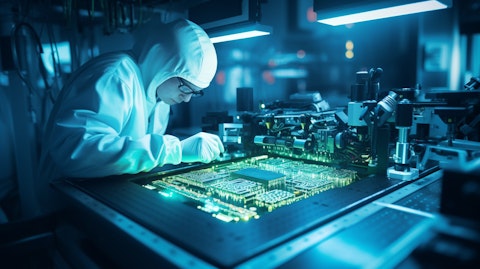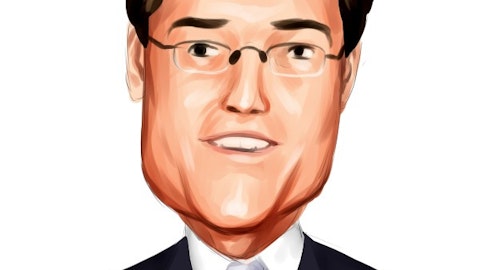Lam Research Corporation (NASDAQ:LRCX) Q2 2024 Earnings Call Transcript January 24, 2024
Lam Research Corporation isn’t one of the 30 most popular stocks among hedge funds at the end of the third quarter (see the details here).
Operator: Good afternoon, and welcome to the Lam Research Corporation December 2023 Quarterly Earnings Conference Call. [Operator Instructions]. I would now like to turn the conference over to Ram Ganesh, Head of Investor Relations. Please go ahead.
Ram Ganesh: Thank you, and good afternoon, everyone. Welcome to the Lam Research quarterly earnings conference call. With me today are Tim Archer, President and CEO; and Doug Bettinger, Executive VP and Chief Financial Officer. During today’s call, we will share our overview on the business environment, and we’ll review our financial results for the December 2023 quarter and our outlook for the March 2024 quarter. The press release detailing our financial results was distributed a little after 1:00 p.m. Pacific Time. The release can also be found on the IR section of the company’s website along with the presentation slides that accompany today’s call. Today’s presentation and Q&A include forward-looking statements that are subject to risks and uncertainties reflected in the risk factors disclosed in our SEC public filings.
Please see accompanying slides in the presentation for additional information. Today’s discussion of our financial results will be presented on a non-GAAP financial basis unless otherwise specified. A detailed reconciliation between GAAP and non-GAAP results can be found in the accompanying slides in the presentation. This call is scheduled to last until 3:00 p.m. Pacific Time. A replay of this call will be made available later this afternoon on our website. And with that, I’ll hand the call over to Tim.
Timothy Archer: Thank you, Ram, and welcome, everyone. Lam delivered strong performance in the December quarter. Revenues, gross margin, operating margin and EPS all above the midpoint of our guided ranges. Our results for December closed out a calendar year 2023, in which Lam executed well amid a decline in overall wafer fabrication equipment spending. Compared to the prior year cycle trough in calendar 2019, we achieved a near doubling of EPS. There are a few reasons why Lam has evolved stronger cycle to cycle. First, we have improved our positioning in the foundry, logic and specialty technology segments through sustained investments in innovation and new products. As a result, we have grown our total non-memory revenue share, and we continue to gain momentum at key technology inflections.
Second, we have delivered tremendous growth in our customer support business group. Lam ended calendar 2023 with approximately 90,000 chambers in the field, an installed base almost 50% larger than in the previous cycle. CSBG revenue has grown by more than 80% from 2019 levels. And finally, we have further improved our ability to manage costs and drive operational efficiency through cycles, delivering operating margins in 2023 that were nearly 2.5 points higher than the prior trough. Turning to WFE. We estimate that 2023 spending ended in the low $80 billion range. This is up slightly from our prior view, driven by continued strength in domestic China spending predominantly in equipment segments where we do not participate. Overall, memory WFE was down nearly 40% year-on-year, led by cuts in NAND spending of more than 75%.
Non-memory WFE decreased in the mid-single digits range with mature node growth in China, partially offsetting declines in leading-edge node spending in the rest of the world. As we enter 2024, the business environment remains muted. However, we expect a modest recovery in memory spending to drive a stronger exit to the year. Our early view of WFE spending for calendar 2024 is in the mid- to high $80 billion range. Growth in DRAM will be driven by capacity additions for high-bandwidth memory as well as node conversions. NAND spending increases will largely come from technology upgrades. We see foundry logic spend growing in 2024 with higher leading-edge investment, offset in part by declines in mature node investment outside of China. Overall, we believe domestic China spending will be stable in 2024.
Longer term, the setup for WFE investment is robust. With semiconductor revenues widely expected to reach $1 trillion around the end of the decade and device manufacturing complexity continuing to rise, we believe WFE spending will need to roughly double from today’s levels. Lam’s served markets of etch and deposition should outpace growth in WFE overall. For this reason, we have been executing a series of strategic actions to best position the company for the growth opportunity ahead. Importantly, we have remained committed to these initiatives despite the challenging spending environment over the past several quarters. First is our commitment to R&D, including planned spending increases in calendar year 2024 to extend our differentiation in products and services targeted at next-generation semiconductor device inflections.
This next era in semiconductors will be defined by the broad move towards 3D architectures and advanced packaging to solve scaling challenges. We believe this will, in turn, drive an increase in etch and deposition intensity over the long term. Our focus is on multiple billion dollar SAM expansion opportunities across memory and foundry logic. We have profiled our advances in gate-all-around, backside power delivery, advanced packaging and dry EUV patterning over the past several quarters, and our solutions are continuing to gain traction with customers. In the December quarter, we secured additional advanced packaging wins for high-bandwidth memory, which is critical for enabling advanced AI servers. Our SABRE 3D tools, best-in-class plating uniformity along with our ability to demonstrate an overall cost of ownership advantage made Lam the clear choice over a large competitor.
In 2024, we expect our HBM related DRAM and packaging shipments to more than triple year-on-year and outpace WFE growth in this segment by a significant margin. The specialty technology markets are also yielding a diverse set of new opportunities for Lam. For instance, we have recently delivered pulse laser deposition technology to customers targeting high-volume manufacturing of MEMS and next-generation high-frequency devices. We accelerated our entry into this market by integrating technology we obtained via small acquisition onto a production-proven Lam platform. Compared to competing deposition methods, Lam solution enables more highly doped scandium aluminum nitride films, which delivered the piezoelectric performance and cost our customers require.
The second area of focus for Lam has been our investment in facilities close to our customers. By establishing process development capabilities near our customers’ R&D fabs, we are maximizing collaboration and accelerating time to solutions. We have also made progress ramping supply chain and manufacturing operations within our customer ecosystems. These in-region capabilities enhance our responsiveness and resilience for customers and create significant economic value for Lam as we leverage the benefits of global flexibility. Our new manufacturing facility in Malaysia is poised to fully scale in the coming WFE upturn, providing us the capability to nearly triple the percentage revenue contribution from our lower cost manufacturing locations versus a few years ago.
And finally, Lam is concentrated on reengineering our business processing systems to drive operational excellence at greater scale. Investments in digital capabilities like virtual twinning, advanced simulation and AI are helping us to accelerate problem solving, and we are building equipment intelligence capabilities and in-fab service automation into our most advanced product road maps. As we complete our reengineering efforts, we are also intent on achieving organizational agility. In this regard, we are announcing a small workforce reduction predominantly at the executive level to align our resources with our execution priorities and drive efficiency and speed of decision-making. In calendar 2023, Lam delivered solid results while investing to build strong capabilities for the future.
Looking forward, I am confident that our strategic global infrastructure and differentiated technology portfolio provide Lam with the tools we need to capitalize on the robust semiconductor growth expected in the years ahead. Thank you, and now here is Doug.

Douglas Bettinger: Great. Thank you, Tim. Good afternoon, everyone, and thank you for joining our call today during what I know is a busy earnings season. We delivered strong financial results in calendar year 2023. Our revenue came in at $14.3 billion and diluted earnings per share at $27.33. We’re pleased with the company’s execution during the year where the memory WFE mix reached historic lows. Let’s look at the details of our December quarter results. Revenue for the December quarter was $3.76 billion, which was up 8% from the prior quarter and down 29% from a year ago. Our deferred revenue balance at the end of the quarter was $1.93 billion, which was an increase of $238 million from the September quarter, which was mainly tied to growth in customer advanced payments.
We continue to have a higher deferred revenue balance versus historic levels given these customer advanced payments. From a segment perspective, December quarter, systems revenue in memory was 48%, which is an increase from the prior quarter level of 38%. The growth in the memory segment was led by DRAM, which was at record levels on a dollar basis, coming in at 31% of systems revenue compared with 23% in the September quarter. DRAM is benefiting from growth in high-bandwidth memory capacity and the move to DDR5, which is needed to address AI-related workloads, and it’s also benefiting from shipments to China. As we’ve noted in prior quarters, nonvolatile memory WFE was at historic lows on a mix basis in 2023. For the December quarter, this segment represented 17% of our systems revenue, which was up a little bit from 15% in the prior quarter.
The slight growth was predominantly related to investments in certain technology projects. NAND customers have aggressively reduced capacity throughout the year to bring inventory levels down. The Foundry segment represented 38% of our systems revenue, a little higher than the percentage concentration in the September quarter of 36%. Growth was driven by new fab shipments in various regions across several process nodes. The Logic and Other segment was 14% of our systems revenue in the December quarter, which was down from the prior quarter level of 26%. The decline was driven by general mature node softness as well as the timing of customer projects. Overall, in the Foundry and Logic segment, we performed well, delivering on the share gains that we’ve previously been discussing with you.
Now I’ll discuss the regional composition of our total revenue. The China region came in at 40%, which was down from 48% in the prior quarter. Most of our China revenue in the last 2 quarters was from domestic Chinese customers, and we expect spending from this region to be stable overall in 2024. China as a percent of our revenue is expected to stay relatively high in the March quarter, but it likely trend lower as the year progresses. Our next largest geographic concentration was Korea at 19% of revenue in the December quarter versus 16% in the September quarter. And finally, Japan and Taiwan rounded out the remaining of our top 4 regions. The customer support business group generated revenue in the December quarter of nearly $1.5 billion, up 2% from the September quarter and 16% lower than the December quarter in calendar year 2022.
Overall, the business was steady, and we continue to see our memory customers operating the fabs at very low utilization rates. Given the strength of the installed base units, we have a strong foundation for growth with technology conversions and utilization rates resume growing. Spares followed by the Reliant product line continue to be the 2 largest components of CSBG. Turning to the gross margin performance. The December quarter came in at 47.6%, which is above the midpoint of guidance and generally in line with the September quarter level, which was 47.9%. We’ve improved elements of our cost structure during the year and delivered on our commitment to improve gross margin from the 2023 March quarter level by approximately 1 percentage point as we exited calendar year 2023 from those operational improvements.
December quarter operating expenses were $662 million, up from the prior quarter amount of $622 million. R&D as a percent of spending was higher versus the September quarter, coming in at over 69% of total expenses. The increased spending reflects our ongoing focus on extending our product and technology differentiation across those critical inflections that Tim mentioned earlier. We will continue to grow investments across multiple market segments to support the long-term strategic objectives for ongoing company outperformance. Operating margin for the current quarter was 30%, in line with September quarter level of 30.1% and above the midpoint of our guidance primarily because of a stronger gross margin performance. Our non-GAAP tax rate for the quarter was 12.3%, generally in line with expectations.
Looking into calendar 2024, we believe the tax rate will be in the low to mid-teens with the normal fluctuations quarter-by-quarter. Other income expense for the December quarter came in at $5 million in income compared with $7 million in income in the September quarter. The slight fluctuation in OI&E was mainly due to variations in exchange rates. OI&E will continue to be subject to market-related fluctuations that could cause some level of volatility each quarter. On the capital return side, we allocated approximately $640 million to open market share repurchases, and we paid $264 million in dividends in the December quarter. For the 2023 calendar year, we returned 79% of our free cash flow, totaling $3.8 billion, which was largely consistent with our long-term capital return plans of 75% to 100%.
December quarter diluted earnings per share was $7.52 over the midpoint of our guidance. Diluted share count rounded down to 132 million shares on track with our expectations and down from the September quarter. During 2023, we repurchased nearly 5 million shares through our share buyback program. And I would just mention, we have $2.1 billion remaining on our Board-authorized share repurchase plan. Let me turn to the balance sheet. Our cash and short-term investments at the end of the December quarter totaled $5.6 billion, up from $5.2 billion in the September quarter. The increase was largely due to collections, offset by cash allocated to share repurchases, dividend payments and capital expenditures. Overall, 2023 was a record year for cash flows from operations coming in at $5.3 billion.
Days sales outstanding was 66 days in the December quarter, which was a decrease from 73 days in the September quarter. As a result of our operational focus and execution, I’m pleased to report that inventory turns improved to 1.8x from the prior quarter level of 1.5x. We will continue to work on bringing inventory down throughout calendar 2024. Our noncash expenses for the December quarter included approximately $70 million for equity compensation, $78 million for depreciation and $13 million for amortization. Capital expenditures for the December quarter were $115 million, up $38 million from the September quarter. Spending was primarily centered on product development activities and lab expansions in the United States and Asia, supporting our global lab investment strategy.
We ended the — excuse me, the December quarter with approximately 17,200 regular full-time employees, which was flat with the prior quarter. Let’s now turn to our non-GAAP guidance for the March 2024 quarter. We’re expecting revenue of $3.7 billion, plus or minus $300 million. Gross margin of 48%, plus or minus 1 percentage point. This gross margin guidance is reflected — reflective of continued favorable customer mix. I do expect this favorable mix to mitigate somewhat as the year progresses. Operating margins of 29.5%, plus or minus 1 percentage point. I would again highlight that the March 2024 quarter will have higher spending as it includes an extra week in the quarter, which occurs every several years. It’s a 14-week quarter. And I will also remind you we will be growing R&D spending this year.
And finally, we’re expecting earnings per share of $7.25, plus or minus $0.75 based on a share count of approximately 132 million shares. We continue to be focused on improving our business operations to optimize efficiency and effectiveness as WFE growth occurs. Our profitability metrics reflect the progress we made during calendar year 2023, with business realignment and transformational activities well underway. We’ll see these activities continue in the first half of calendar year 2024. Including the cost incurred for these improvement activities and headcount reductions that we saw in calendar 2023, I now expect we’ll spend in total $300 million for these actions, which will continue to be reported in our non-GAAP adjustments. I had previously told you we would spend $250 million over 12 months.
It’s now $50 million higher and 6 months longer. So let me conclude. Over many semiconductor cycles, Lam has established a proven track record of successfully managing our business. With the actions we’ve taken over the course of the last several quarters, we expect to strengthen our operations and technology leadership and further enhance our profitability profile. When revenue scales into the next upturn, Lam will be stronger, better positioned and more efficient. Operator, that concludes our prepared remarks. Tim and I would now like to open up the call for questions.
See also 16 Countries That Produce the Best Architects in the World and 11 Stocks with the Biggest Buybacks.
Q&A Session
Follow Lam Research Corp (NASDAQ:LRCX)
Follow Lam Research Corp (NASDAQ:LRCX)
Operator: [Operator Instructions]. Our first question today is from Tim Arcuri from UBS.
Timothy Arcuri: I guess my first question for you, Tim, is I wondered if you could sort of translate. Obviously, you heard your big litho peer that reported today that had these huge orders and it looks like a couple of billion dollars in EUV orders for DRAM. So that sort of translates to an extra $9 billion to $10 billion, something like that. So it seems mostly for shipments during this year and even into next year for them. So like maybe you haven’t seen that yet. But can you talk about what that tells you about the future of that segment? And I know you think it’s going to be up, but it seems like it could be up a lot. And maybe any change in the planning outlook or the discussions that you’re having with your DRAM customers?
Timothy Archer: Sure. Thanks, Tim. And obviously, WFE is a tricky thing to forecast because generally, we have a very good view of certain segments of the market. And we try to give an overall view of WFE, and we do that based on listening to peers, talking to customers and making our own assessments. Yes, sometimes we get it wrong. And I guess we’re always in a period of adjusting that. I think though — I didn’t — I don’t think there’s anything out there that is completely inconsistent with what we’ve said. We’ve said WFE is up this year, modestly recovering because of memory. It’s — we’d see a stronger exit to the year. And I think to the magnitude, I think we’re just going to keep watching it and having those conversations with customers.
In this period, lead times of equipment and the framework in which certain pieces of equipment need to be ordered and brought into fabs can differ equipment supplier to equipment supplier, and maybe there’s something at play there. But I think it probably further reinforces our bullishness that memory has been at a historically low mix of WFE. We said that memory spending across both DRAM and NAND. We felt was at unsustainable levels. We said that on pretty much every call last year. And — so I think that it’s not a surprise that, that eventually corrects itself. What I would point out is that we don’t spend a tremendous amount of time trying to get the timing exactly right. In my script, I talked a lot about strategic actions, which play out over years and, in fact, catch the DRAM inflections that are coming now.
The strength we have in high-bandwidth memory, the positions we have in applications in DDR5 and beyond. Those were established by us seeing DRAM opportunities years ago. And I think we’re continuing to report more and more growth in that segment. And I think we’ll just continue to do that. So we tend to take a long-term view of technology and spending patterns.
Douglas Bettinger: And Tim, it’s Doug. I’ll just remind you something that I know you know very well that with those lead times are generally much longer than ours are in etch and deposition. And you never buy litho without eventually buying the process equipment that goes along with it. So if they’re seeing something, we will see it, too.
Timothy Arcuri: Totally, Doug. Yes, for sure. So I guess for you, Doug, super quick. So there’s kind of a lot of moving parts, I know going on in gross margin. I know that the mix is helping you. And I know you’re probably getting some tailwinds from some cost relief and things like that. So what’s the right normalized margin? I know maybe 48% is not the right normalized number, but is it like is the mix helping you by 50 basis points, and that’s what sort of goes away. Can you sort of help us there?
Douglas Bettinger: Yes. Tim, I’ll remind you what I said last quarter call too, still kind of the same thing. The customer mix is benefiting us again in the March quarter guide, maybe even a little bit more than it did last quarter. I took you back to that June quarter of last year before we had such a favorable geographic mix and that largely is what’s driving the customer mix. We were around 46% gross margin, 45.7%, I think, if I remember the June quarter specifically. That’s not a bad place to kind of start when mix normalizes back to maybe more normal levels. So think about it that way. Somewhere in between there and where we are here. These operational improved install that we’ve been talking about are real things and as growth resumes and we know growth will resume at some juncture, we should benefit from like repositioning the company to these lower cost locations. So that’s still on the come line. but it will require some level of growth in the business.
Operator: The next question is from Harlan Sur with JPMorgan.
Harlan Sur: Again, going back to your large litho peer that reported this morning, right? They called out seeing an increase in customer utilization of their litho tools, both in memory and in Foundry and Logic, appearing that this is the early signal of a positive turn in cyclical dynamics. I know you guys are also track in real time utilization, activity rates of your customers. I know they’re at very low levels, but are you guys starting to see some pickup in utilization rates across your customers? And is that also maybe giving you further confidence in your modest growth outlook for WFE this year?





